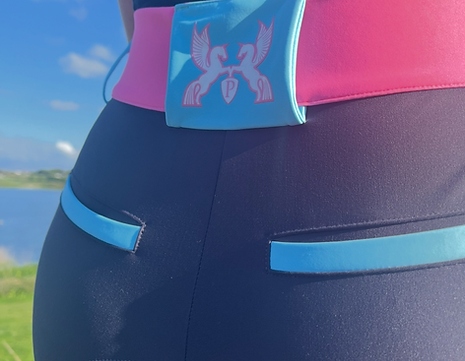How Hip Extension Improves Rising Trot - Visual Rider Feedback with SymmFit
- Jennifer Symms
- Jun 7
- 3 min read
Rising trot is one of the first skills most riders learn. But while it may seem simple, many riders unknowingly develop poor movement patterns here that can affect their balance, rein contact, and the horse’s way of going.
One of the most common issues I see in Rider Physio sessions is the loss of correct hip mechanics - especially in rising trot - which leads to an unbalanced or forward weighted rider and a horse having to try and adapt.
When the rider is not using proper hip extension and flexion, the result is often:
Driving the rise from the knees instead of the hips (think standing up)
Tipping the upper body forward
A swinging or unstable lower leg
Blocking or chasing the horse’s movement
Disrupting rein contact and stability
Causing tension in the horse
By contrast, when the rider maintains controlled, well-timed hip extension and flexion:
The rising trot becomes balanced and fluid
The upper body remains upright and stable over the horse’s centre of gravity
Rein contact stays elastic
The horse can move more freely and with better rhythm
The Role of Hip Extension in Rising Trot
Good rising trot mechanics involve controlled extension through the hip joint. The movement should come from the hips opening and closing in time with the horse’s motion, not from pushing through the knees or gripping with the thighs.
At the same time, the rider needs:
Core stability to maintain a neutral spine
Balanced shoulder-hip-heel alignment
A pelvis that moves elastically with the horse
When this doesn’t happen, we typically see:
The rider leaning forward or collapsing through the upper body
Overuse of the knees and gripping with the thighs
Inconsistent rising rhythm
Loss of stability and disrupted rein contact
Horses showing tension or irregularity
Many riders are unaware of these patterns - and often cannot feel when their hip mechanics are compensating in this way.
How Rider Feedback with SymmFit Helps You See This
This is where SymmFit tops can make a significant difference. One of the key features of SymmFit is that the visual lines and contrast panels are visible from the side (unlike other biomechanics clothes) so we can see the angle of torso and hips clearly.
In rising trot, SymmFit tops help reveal:
The angle between the torso and thigh
Whether the rider is truly extending through the hips
Whether the upper body is staying in alignment or tipping forward
Filming your rising trot while wearing a SymmFit top provides instant visual feedback. Many riders are surprised when they see how much forward tipping or knee-driven rising is present - even when they thought they were staying balanced.
This is a great exercise to practice off horse- keeping upper body upright, and lifting hips up and forward and slowly lowering back down. Don't be tempted to lean forward on the way back down! This works the front of your thighs as you have to eccentrically control the movement - the important part about controlling the landing on a horse.
When hip extension improves, riders typically notice:
Improved balance and alignment
More consistent rising rhythm
Lighter, more elastic rein contact
Greater comfort and freedom in the horse’s movement
A Simple Self-Check
To check your own hip mechanics in rising trot:
Film yourself from the side in rising trot while wearing a SymmFit top.
Observe the angle between your torso and thigh. Are you staying upright or are you tipping forward? What are the pink panel and blue lines doing?
Check the position of your shoulders relative to your hips. Are they stacked vertically, or are they pitching ahead or behind your hips (getting behind the movement)? What's the blue line on sleeve looking like?
Being able to see these details - which can be difficult to feel without the rider feedback with SymmFit - is key to improving rising trot biomechanics.
Summary
Controlled hip extension is essential for balanced, effective rising trot. Without it, riders often compensate in ways that disrupt the horse’s movement and rein contact.
SymmFit tops provide a simple, effective tool to help riders see and correct these patterns:
By making body angles and alignment visible
By allowing riders to track changes and improvements over time
By supporting better rider biomechanics and improving the horse’s comfort and way of going
For many riders, this is one of the first steps toward a more balanced, connected, and effective seat - and rising trot is the ideal place to start developing these skills. Buy your SymmFit Training Top now to start to see it before you can fix it!





Comments